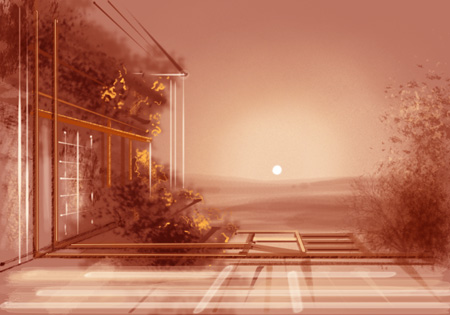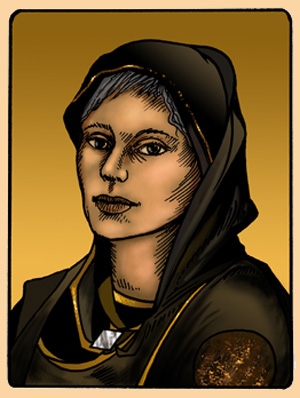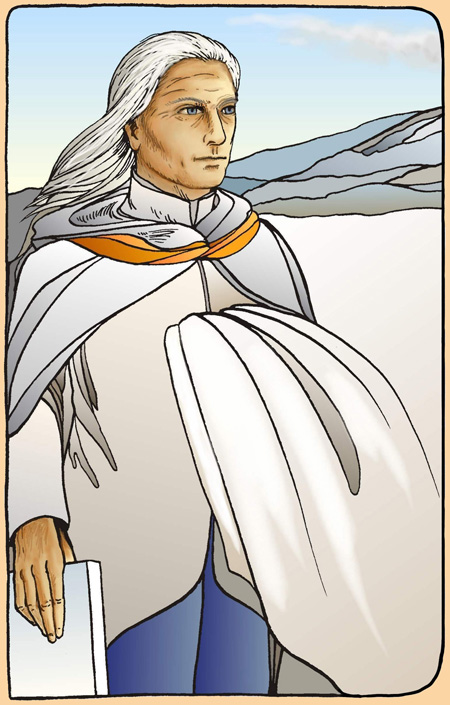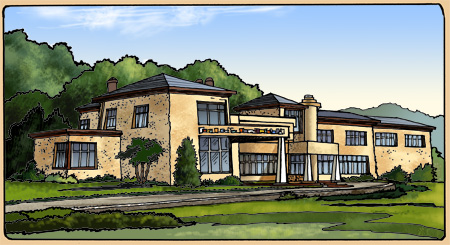The House in the Red Desert
This image was safely retrieved from an Old World archive. Nothing is known about who built or lived in the structure or even what planet it might have been on. The architecture suggests a residence or perhaps a resort, with the viewer's point being on an outdoor deck.

Contributed by Archivist Bana Ortaya, Sardana Task Group 422.
Posted at 11:24 pm | link
A Call for Entries from the National Conservatory of Khemi
By Sosthenie P. Ampelian
The canon of Khemaru serious music has been closed for the more than two hundred years that the National Conservatory has existed on New Earth. In fact, the idea of creating new pieces for this Canon has been consistently rejected by the elders of the Conservatory. The directors maintain that the Canon contains so many wonderful pieces, many of them almost unknown, that any new work would only distract from the unfolding of our traditional cultural heritage in the New World. The excellent musicians of the National Kanounic Orchestra as well as their chamber music subgroups are happy to play the pieces from what is considered the "golden age" of music. That was that felicitous time back in the Old Empire when Khemaru society was as harmonious as its music, guided by the enlightened intellectual class.
It has taken us two hundred years after the brutal disruptions of the Crossing, the years of misguided Socialist rule, and the re-establishment of our order, but Khemaru society, as our monitors agree, is now worthy of moving forward to reclaim our heritage as a cultural leader in the New World. This will, of course, include music. The question remains, though: how is that to be done? There are some impressive developments in the last twenty years, such as the establishment of the Paleomusical Orchestra in Surakosai, as well as the revival of the Enharmonic Intonation of the great composer Tirunesh. The National Conservatory in our own capital city Masri, responding to the challenge, has made what some consider a bold move. They have relaxed some of their repertoire restrictions and have declared that there is room for newly composed music in the Canon of playable works.
We are not naive enough to think that no new music has been composed without the sanctions of the Conservatory over the last two centuries. It may even be that some of these works are worthy of inclusion. But the vast majority of them are done by mediocre and ill-trained imitators, often as soundtracks to cinema or other popular entertainments. There may be hundreds, or even thousands of these would-be composers. How can one find the rare jewels in the sonic rubble? The Conservatory has attempted to draw them out by its new "Call for Entries," a musical contest for new composers and new pieces. The winners of this contest will have their works played by the Orchestra or its subgroups. There is a monetary prize of 32,768 Piasters, which is quite a lot for any musician struggling to build or keep a career. (Translator's note: the exchange rate is currently 6.5 Piasters to one U.S. Dollar.)
The judges will be the Elders of the Conservatory, and the rules are quite strict. Here is a sample of some of the qualifications:
"The National Conservatory of Khemi offers these criteria for musical entries:
1. The music must follow a historically known and relevant paradigm, and be in agreement with the greatness of past masters though without actually imitating them.
2. Compositions must be balanced, refined, elegant, and mathematically sound, in keeping with our Khemaru ideal of rationality and order.
3. Entries must be in a classical, restrained style, untouched by the savage pounding and vulgar filth of popular mind-infection.
4. Music should be aesthetically beautiful, graceful and perfectly proportioned. We would prefer that it err (if that should be the case) in being too brief rather than being too lengthy.
5. The artist should remember that art is a serious matter, and any piece that is chosen will be placed in the Canon, a work for the ages. Therefore a composer must offer something that could live for millennia, rather than a trivial following of the moment's trends, fads, or fashions."
As a critic, I am always in favor of the Canon and its axiomatic principles, but I wonder just how restrictive this contest's rules can be if the Conservatory wishes to find something that is both new and of value. Innovation, as we well know, is not intrinsically good, yet there must be some motivation to bring it about in a constructive way. With criteria like these, one wonders whether they will get enough entries to make the judgement worthwhile.
Sosthenie Phaeris Ampelian is a correspondent for the Khemaru Cultural Review.

Posted at 4:26 am | link
Remembering Enlil
by Anthimia Kaltagiron
Noantri Date, 25 Eridan 228
It is now almost two years since Enlil disappeared at the summit of Mount Aitna. Enlil is one of the few people of our New Earth era who is recognizable to all by just one name. He is undoubtedly the greatest Theophore master of those born after the Crossing, and here in Trinacria, where he made his home, he is still everywhere, though he himself is now nowhere.
Enlil at the slopes of Aitna, from a publicity image

Look in any general store or souvenir vendor's booth and you will see Enlil cards, Enlil portraits, copies of Enlil texts and cinema, Enlil statuettes and action figures, garments with his image printed on them, and even, believe it or not, Enlil dinnerware. Most of this has sprung up since his disappearance, but it was already going strong before he left this world, without any objection from the man himself. The more intellectual of us can read numerous memoirs by Enlil's associates or friends or admirers, and even the renowned writer on matters theophoric, Tasrin Nazar, is said to be working on a book about him.
I came to the Institute after Enlil had retired, so I never got to see him day-to-day here. But he would often visit, breezing through every couple of months on his way to a lecture or public appearance or scholarly meeting, and so he did make an impression on me. Apart from a couple of meetings in my childhood years, I mostly knew him in his old age — when I met him as a professional member of the Institute staff, he was already over eighty — but it seemed that age hardly slowed him down. His long hair, which had been a kind of ashy grey in his younger days, was pure white as he grew old. And his white cloak, along with his habit of wearing white and light colors with orange accents, made him seem like a flying cloud touched with flame as he made his regal way through the halls of the new Institute which his own financial success had helped pay for.
Meeting him was like meeting someone out of legend — which, of course he had created for himself with his movies and his books and his theophoric exploits. This was the theophoric sorcerer who had stopped the lava flow that had threatened the the town of Katana and its environs. This was the hero of cinemas we have all seen: "The Fire Prophet," "Theophore Master of the Volcanic Isles," and "Orange Sun" among them. Shaking his hand and looking into his bright blue eyes, you were overwhelmed with his pure charisma.
Throughout his life he was in opposition to his Lord of Memory kinsmen, who found his involvement with popular culture appalling. And yet it was his playing with popular culture that made theophorica less threatening to the public. By his example, he gave the masses a perception of a Theophore not as a threatening, secretive wielder of arcane powers but as a heroic friend to society. Ironically, he also gave the Lords of Memory a familiar and positive face. Before Enlil's fame, the Lord of Memory ethnicity was known only as a source of mind-workers for universities and consulting firms all over the world; relentlessly intellectual, and in their white uniforms, almost invisibly bland. That irony was even more pointed if you knew his ancestry; Enlil was only half Lord of Memory. The other two quarters of his genetic heritage were Khemaru and, more embarrassingly for the purists, Tisari.
The mystery of his disappearance is still unsolved, though there is no suspicion of any foul play. The known facts are that despite his advanced age (he was 86 years old) he climbed to the edge of the crater of Mount Aitna during one of its active phases. Enlil was obsessed with volcanoes, especially our own Monjibedu ("Beautiful Mountain," to those who don't know our local dialect) and would go to the summit at least twice a year. He was accompanied by his disciple of the time, a young theophore in training named "Rorya," and this young man is the only eyewitness to the event. According to Rorya, Enlil handed him his cape and computer and climbed to the crater rim unencumbered. It was hard to see in the fog and the steam coming from the crater. Suddenly there was a shudder and a huge blast of orange flame erupted from the crater, as Rorya ran for his life. When the blast subsided, Enlil was gone.
Reasonable evidence points to a risk ill-taken. The sudden brief eruption caught him at the crater and incinerated him, with no remains left to identify. And yet there have been all sorts of mythological attempts to explain this as some sort of transition to a "higher state," where Enlil has become some sort of non-physical yet conscious entity. This myth-creation started within days of the disappearance. People began seeing Enlil in their dreams, in fantasies, in waking visions. An apparition of Enlil is said to have left a very real orange lily flower on a table at a popular restaurant in Katanya. Residents of Acragas have reportedly seen him wandering on the ramparts of the Library high above the city, as he did so many years ago when the library was newly founded. And on the coast, among the luxury estates and exclusive private resorts, his old compound sits deserted. His sprawling laboratory-house, once meant to be the home of a Theophoric Institute, is empty and in disrepair; the locals refuse to go near it, claiming that it is "haunted."
Enlil, then, is not so much "remembered" as "perceived," in a persistence of vision and memory which has less to do with his literary and cinematic fame as his presence in the substrate, the technical term for the collective subconscious of a nouetic people. "Enlil is alive!" has become a catch-phrase that describes not a physical existence but a psychic one. He is alive as a shared imaginary character, built from a constructed persona. Such a person will live for ages, even though the real man is gone for good.
Anthimia Kaltagiron is Director of Publications at the Nouergic Institute at Surakosai, and is also a contributing editor and writer for "The View from Surakosai."
Posted at 3:02 am | link
Coastal Property of Distinction

Three hundred and fifty stadia south of Surakosai on the "Coast of Light," this Keilian-inspired residence was built to modern Tisari standards. Six bedrooms and two master suites look out onto the Middle Sea. The house extends back into a landscaped park containing outbuildings for servants and guests. The property of 12 hectares includes a private beach and mooring as well as a lifter landing pad. It is fully equipped with satellite uplinks and a state-of-the-art security perimeter, as well as an extensive nouetic privacy and defense system. Offered at 24 million Trinacriats. Contact information on request.
Noantri Date: Eridan 21, 228 A.C.
Posted at 2:22 am | link
Archives:
October 2011 (1)
September 2011 (1)
September 2010 (1)
July 2010 (2)
June 2010 (1)
May 2010 (2)
April 2010 (14)
March 2010 (3)
June 2009 (1)
May 2009 (1)
April 2009 (3)
March 2009 (2)
February 2009 (4)
January 2009 (4)
August 2008 (1)
April 2008 (2)
March 2008 (2)
February 2008 (4)